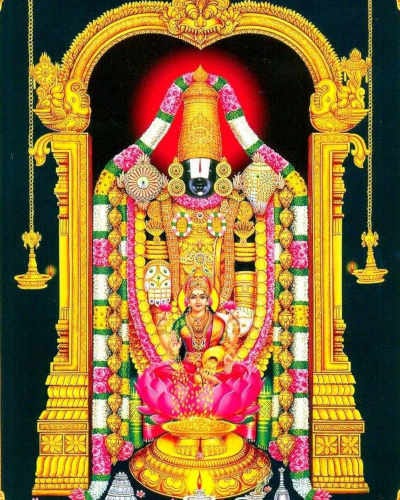Why Lord Venkateswara is not a form of Devi but the form of Lord Vishnu

/***
Forget secular history, many of us do not know that Tirupati among the holiest of temples in South India was once dedicated to the Mother Goddess.
Only under Ramanuja in the 11 th century AD dud the worship of Bhagwan Vishnu begin in Tirupati.
***/
Om Namo Venketasaaya!
This was raised by a friend and here is my posting on this subject, negating this claim.
I think, here is the reference is to Lord Venkateswara, who is the presiding deity at Tirumala, the hill part of generic locational reference called “Tirupathy”.
Here are some evidence that are pre-dating Bhagawad Ramanuja.
Reference in Puranas: The Sthala Mahatmyam of Sri Venkatesvara is called “Sri Venkatachala Mahatmyam” and is mentioned in the following puranas — Padma purana, Garuda purana, Brahma purana, Varaha purana, Markandeya purana etc
Inscription: An inscription in the temple mentions about “Venkatchala Mahatmyam” that gets recited in the temple, even today
Literature:
1. This holy place has been mentioned in Tamil grammar work called “Tholkappiam” (Before CE) that has a reference to Tirumala
2. There is a reference about the Lord in the ancient Tamil classic literature like “Silappathikaram” and poetic compendiums like “pathupattu” and “purananuru”.
3. 250+ verses have been dedicated and sung about Lord Venkatesa in devotional poems of “Nalayira Dhiva Prabandam” (sung by 12 devotees/Alwars), who pre-dated Bhagawad Ramanujacharya. There are passing reference in another great devotional poems called “Thevaram” (by the devotees of Lord Siva)
4. In the Tamil epic “Kamba Ramayanam, there are references about this Lord
Some of the statements shared with a claim for Sakthi/Devi Idol. Vaishnava scholars have placed the counter points to negate this claim:
1. On the top of the central vimana, a lion Pratima is placed and it is the emblem of Devi — As per the major two agamas that help to govern — Vaikhanasa & Pancharatra, there is a provision to place lion or garuda on the vimanam/gopura/walls
2. This Lord is fondly referred to “Balaji’ beyond Vindhyas (Devi is also referred to Bala) — As per the temple inscriptions and literary records, this name is in vogue from 17th century only. There is a possibility that this word “Bala” is derived from the playful act of Lord Krishna, who is associated with this temple
3. As per Devi scholars, this hill is called “Meruchakram” — None exists (to the best of my research) exists in the Devi agamas/sastras. In fact, this hill carries the name “Venkata” and has scriptural reference that is at least 2000 years old
4. The drapery/vastra is a long that resembles the female’s cloth — This is also of recent origin and mainly to protect the moorthi from scratches, since more & more ornaments were given by the Rayas and after them
5. Sandal paste & Turmeric are used that are generally used by/for the Women — Again, they are of recent origin (15th CE and after). In the many Vaishnava temples that practice the aforesaid agamas, these two occupy important place in the Vishnu temples (Lord Vishnu is considered as the alankara Priya…)
6. There is a reference to Lord Venkateswari in Devi Bhagawatham — It is generally alluded to the sakthi aspect of the Gods in Hindu pantheon
7. Sri-sooktha associated with Devi/Mother worship is recited during Abhisheka. Along with this, Purusha-sooktham, Narayana-sooktham, bhoo-sooktham, Neela-sooktham etc are also recited. This is the common practice in the temples that come under the ambit of Ramanuja Sampradaya

The Moolavar/Dhruvabhera/Main idol is part of the 8 self-manifested/svayam-vyaktha-moorthis that are celebrated in Sri Vaishnavism.
Lo, behold, our Lord-in-discussion is also part of that celebrated list. This is mentioned in one of the poems of Saint-poet Sri Nammazhwar (The prime among the 12 Azhwars of the Ramanuja Sampradaya). There are 5 forms of the Lord at different levels; Here, out of compassion and to benefit us, from the “Param” (highest level of his form in Vaikunta) in the “Archa-avatara” form. It was further corroborated by some of the other Azhwars — The devas under the Leadership of Lord Brahma had decided to pray for the appearance of Lord in the idol form at Thirumala
